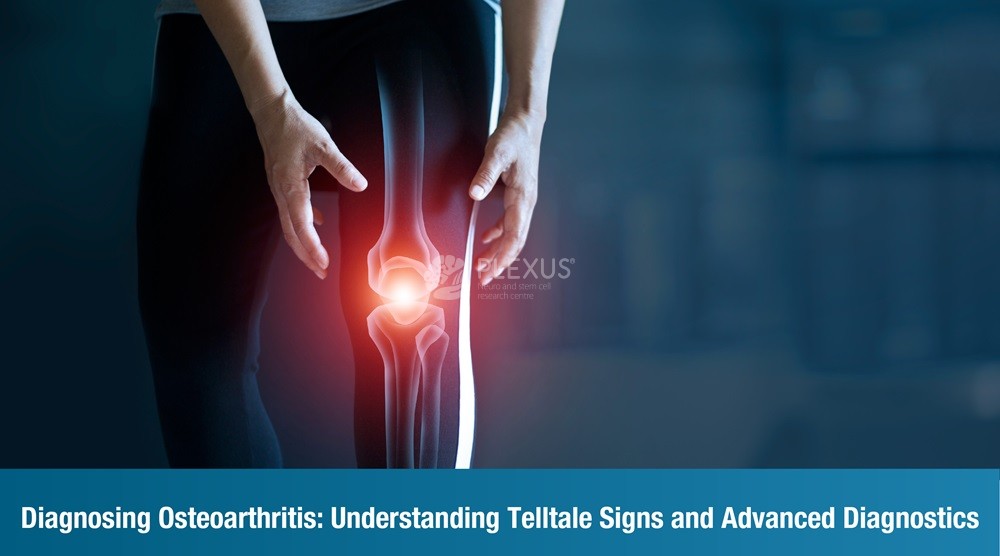
Affecting millions of people across the world, osteoarthritis is a degenerative joint disease that primarily impacts weight-bearing joints, including the knees, hips, and spine. In most cases of osteoarthritis, early diagnosis can help in symptom management and slowing down the progression of the condition. Through this blog, we will help you understand the different methods involved in diagnosing osteoarthritis, such as clinical evaluation, imaging techniques, and more.
Understanding Osteoarthritis
Cartilage helps the bones glide over each other allowing the normal function of the joints. They also help absorb shock. When this cartilage wears down the joints do not move smoothly as they are meant to. This degeneration of cartilage leads to osteoarthritis. Affected joints will be painful, tender, swollen or red. The range of motion will also be affected.
The tissues in the joint sometimes go into overdrive trying to fix the damage. Some changes that might happen include development of osteophytes or bony spurs at the edge of the joint, the synovium that produces synovial fluid might thicken and produce extra fluid, the ligaments that hold the joint together might toughen trying to make the joint more stable.
When osteoarthritis becomes severe, the cartilage wears down to a very thin layer. The bones might start to rub against each other, thickening and creating more pain. The bones might get forced out of their normal position and might even change the shape of the affected joint.
Osteoarthritis usually affects aged persons. In younger individuals, joint injuries (repetitive movement at work or sports injuries) might cause osteoarthritis. Being overweight can also put pressure on the joints and lead to osteoarthritis.
Diagnosing osteoarthritis
Clinical Evaluation
Medical History
Family history of OA, symptoms, location of pain or difficulty, kind of discomfort experienced, details about when or how the discomfort is experienced, current diet and medication, daily activities, exercise routine, and more. Patients might indicate stiffness in the joints when getting up after sitting or lying down for a while; or a sound in the joints when moving it; or tenderness when walking or when shifting weight.
Risk Factors
Knowing the patient’s risk factors is essential. OA is more prevalent in older adults, women, and those with a family history of the condition. Additionally, obesity, joint injuries, and excessive joint stress increase the likelihood of OA.
Physical Examination
Key aspects of a physical examination include:
- Assessing joint pain, tenderness, and swelling
- Evaluating joint range of motion
- Checking for joint crepitus (a grinding or popping sensation) during movement
- Checking for altered gait (indicative of OA in the lower extremities)
- Checking balance and coordination
Functional Assessment
This includes assessing any limitations in daily activities or difficulties in performing tasks. Evaluating the patient’s ability to carry out activities of daily living is critical to arrive at a conclusive diagnosis.
Imaging Techniques
X-rays
They can reveal joint space narrowing, osteophyte (bone spur) formation, and the condition of the surrounding bone. Radiographic evidence helps in confirming the diagnosis.
Magnetic Resonance Imaging (MRI)
These can detect cartilage damage, ligament injuries, and inflammatory changes in the joint.
Ultrasound
These can visualise soft tissues, such as the synovial membrane and tendons, in addition to bone. It can also help diagnose early stages of OA, and can enable guiding procedures such as joint injections.
Computed Tomography (CT) Scans
They can provide three-dimensional images of the joint, which can be useful for surgical planning and assessment of joint abnormalities.
Joint Aspiration
Rarely, the doctor might perform a joint aspiration. A needle might be inserted into the joint after numbing it, to draw out joint fluid. This is checked to assess the health of the joint and to rule out other medical conditions like gout.
Early detection and prevention
Detecting osteoarthritis in its early stages can allow for timely intervention and management.
Additionally, individuals with a family history of osteoarthritis must go for regular check-ups, maintain a healthy lifestyle, and be mindful of other risk factors, such as obesity, and joint injuries. Implementing weight management, physical activity, and joint protection strategies can help prevent the onset of OA or reduce its progression.
At Plexus, we believe in the power of mesenchymal stem cell therapy when it comes to managing chronic conditions like osteoarthritis. Injected stem cells have the potential to regrow cartilage, modulate the immune system, as well as slow down disease progression. Here’s a quick glimpse of what we can do for you or your loved one who may be suffering from this debilitating condition.
To know more about osteoarthritis and understand how best you can manage this condition, reach out to Team Plexus today.
WhatsApp +91 89048 42087
Call +91 78159 64668 (Hyderabad) | +91 82299 99888 (Bangalore)
FAQs
What are 2 symptoms of osteoarthritis?
Pain in a joint, generally accompanied by stiffness and localised swelling is a common symptom of osteoarthritis.
What is the main cause of osteoarthritis?
Age, weight, repetitive stress injuries, and family history are the most prominent causes of osteoarthritis.
What is the newest treatment for osteoarthritis?
Stem cell therapy is the newest treatment for osteoarthritis. It helps manage symptoms of the condition, and also slows down disease progression, thereby allowing the individual to lead a normal life as much as possible.










